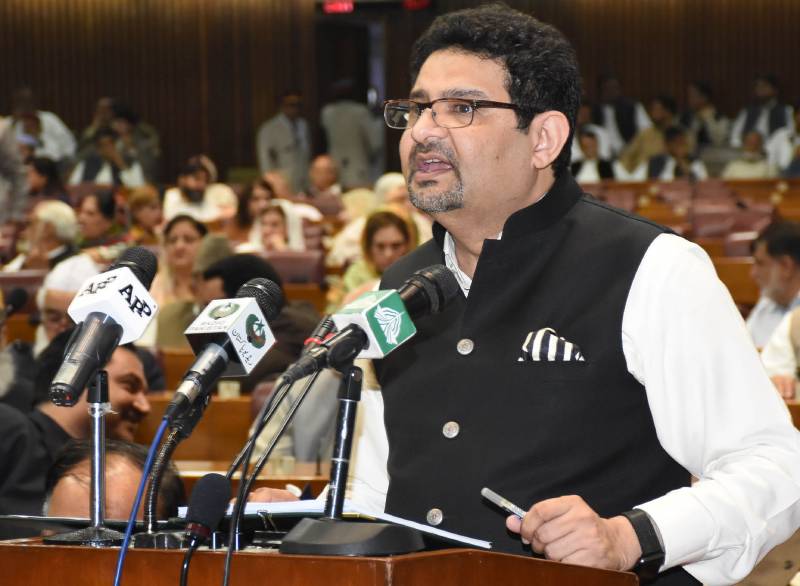Finance Minister Miftah Ismail Friday unveiling a budget outlay of Rs 5.932 trillion, announced a growth oriented budget setting the GDP growth target for 2018-19 at 6.2 per cent with the ever high proposed revenue generation at Rs 4435 billion against total expenditure of Rs 5246 billion.
Presenting the sixth budget of the Pakistan Muslim League(N) government before the general election, Miftah Ismail said the main targets include keeping inflation below six per cent. He said the government is set to achieve a growth target of 5.8 per cent for the current year, the highest in the last 13 years putting Pakistan among the fastest growing economies.
The high growth rates over the last five years have produced unprecedented economic expansion. Size of the economy expanded from Rs 22,385 billion in FY 2013 to Rs34,396 billion in FY 2018, while per capita income increased from 129,005 in 2013 to Rs 180, 204 billion, he added.
Last year, the government achieved GDP growth of 5.4 % which was the highest growth rate in the last 10 years. In contrast, the average GDP growth during the period 2008-12 was a paltry 2.8 percent per annum.
For next year, the federal gross revenue is estimated at Rs 5,661 billion. As compared to revised estimates of Rs 4992 billion in 2017-18, this is higher by 13.4 percent.
This includes FBR tax estimate of Rs 4,435 billion as compared to revised estimate of Rs 3,935 billion for current year.
Out of the total revenues, the provincial governments share is estimated to be Rs 2590 billion as compared to Rs 2316 billion revised estimates for 2017-18, showing an increase of 11.8 percent.
After transfer to provincial governments, the net revenue of the Federal Government is estimated at Rs 3,070 billion in 2018-19 as compared to revised estimates of Rs 2676 billion in the current financial year. Total federal expenditure for 2018-19 is budgeted at Rs 5932 billion, compared to the revised estimates of Rs 4857 billion for 2017-18, showing an increase of 8 percent.
Interest payments for 2018-19 have been budgeted at Rs 1620 billion against the revised budget of Rs 1526 billion for 2017-18. The defence budget is proposed at Rs 1100 billion against the revised budget of Rs 999 billion in the current year.
Total size of federal public sector development programme would be Rs 1030 billion against the revised estimates of Rs 750 billion. Provincial surplus is estimated at Rs 286 billion against revised estimate of Rs 274 billion. Budget deficit will be kept at 4.9 % of GDP as opposed to 5.5% of GDP in 2017-18.
While giving details of the past years performance, he said the agriculture sector showed the highest growth in the past 18 years of 3.8 percent. Industrial production grew by 5.8 percent. Services sector including banking, retail, transportation, showed a remarkable growth of 6.4 percent.
Inflation considered the biggest tax on poor people, was at average of 5 percent in the last five years, compared to 12 percent between 2008-13 percent. In nine months of this year, inflation was only 3.8 percent while food inflation was only 2 percent.
The fiscal deficit was contained below 5.5 percent of GDP while in 2013 the fiscal deficit was at 8.2 percent. In 2013, FBR tax collection was at 1,946 billion while for the current year, the revenue is projected to increase to Rs 3,935 billion.
The State Bank kept the policy rate at 5.75 percent in 2017, which was the lowest in many decades, allowing businesses and industry to grow and create jobs.
The government increased target of agriculture credit from Rs 315 billion in 2013 to Rs 1001 billion in 2018. For the next year, the target is being increased to Rs 1100 billion.
The minister also informed that the local film industry will be provided a fiscal package, including reduction in custom duty to 3 percent on the import of equipment, a rebate of 50 percent in income tax to companies investing in film projects and 50 percent tax rebate to income derived by foreign film makers.
Miftah said another new programme “100 100 100” will be launched to ensure 100% Pakistani children are enrolled in schools.
Other notable programmes include Rs 10 billion to address the problem of child stunting, Rs 35 billion for railways with a plan to increase the speed of trains from Peshawar to Karachi by 3 times from 55 km to 160 km by hour by 2021.
The government in five years added 12,230 megawatts to the national grid and will invest a further Rs 138 billion in power sector while Rs 310 billion will be spent on construction of motorways.
The minister told that Rs 44.7 billion is proposed for AJK and Gilgit Baltistan and Rs 24.5 for Federally Administered Tribal Areas (FATA). Rs 10 billion has been approved to implement a ten year development plan for FATA and Rs 90 billion for rehabilitation of millions of people who had to leave their homes in the areas of military operations.
The government is enhancing PSDP allocations for Higher Education Commission to Rs 57 billion and will allocate Rs 37 billion for primary health programmes and Rs 10 billion for youth programme. Rs 137 billion are proposed for development of Gwadar port.






